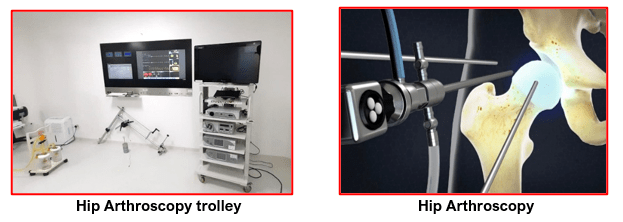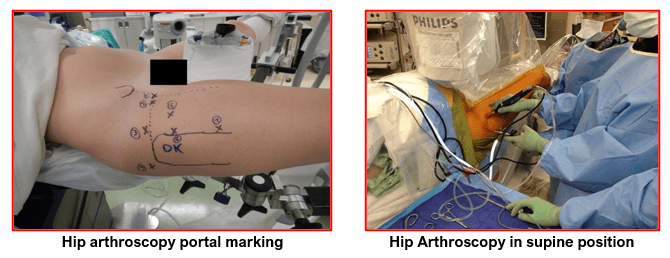Hip Arthroscopy
Hip arthroscopy is a commonly performed key-hole surgery of the hip joint. It is used to visualise, diagnose, and treat various problems inside the hip joint and in the surrounding areas.
The surgeon first makes a portal (tiny keyhole) around the hip joint. He then inserts an arthroscope (small telescope), with attached light source and a video camera, to look into the hip joint. He then creates additional 2 to 3 portals as needed and inserts specialised instruments through them for various surgical steps.

The images from the hip joint are seen on a large screen monitor which helps the surgeon to diagnose or treat multiple hip problems as needed under arthroscopic vision. Images of the hip pathologies and videos of the surgery performed can also be recorded for documentation purposes. A majority of the patients get discharged from the hospital on the same day of surgery or the next day.
Hip arthroscopy is a relatively new but safe procedure in Orthopaedic Surgery. It has been made possible within the last decade due to advances in surgical instrumentation and techniques.
These techniques have revolutionized the treatment of disorders such as femoro-acetabular impingement (FAI) and labral tears. Problems within the hip joint that could not be reached previously, or accessed only through open incisions, can now often be successfully treated arthroscopically and the indications for hip arthroscopy continue to be developed.
Dr Anand Jadhav has 25 years of surgical experience. He has undergone highly advanced and specialised training in arthroscopic surgeries of the hip joint across multiple centres in the UK, Europe and the USA. He prefers to do arthroscopic hip surgeries at hospitals that have all the necessary specialised equipment along with trained support staff. This helps him in providing best outcomes to his patients.
Hip arthroscopy, being a minimally invasive procedure, offers several advantages:
- Smaller scar which are cosmetically better
- Less tissue injury
- Minimal pain
- Minimal swelling
- Shorter hospitalisation
- Faster recovery
- Ability to dynamically assess tissues when probed or put under tension.
- Better visualisation of certain pathologies compared to open surgery.
- The hip joint is vulnerable to a variety of injuries as well as non-traumatic lesions.
- The most common hip problems where hip arthroscopy may be recommended for diagnosis and treatment are:
- Acetabular labral tears
- Cartilage tears
- Reshaping for Femoral shape problems (“CAM” lesions)
- Acetabular Pincer (overcovering of the socket)
- Ligamentum teres injuries
- Loose Bodies
- Snapping hip syndrome (tendons flicking over the hip)
- Iliopsoas bursitis
- Other indications may include assessment of osteonecrosis of the femoral head (loss of blood supply), rheumatoid arthritis, gout and infection.
- Hip arthroscopy can sometimes also be used to alleviate the symptoms of mild-to-moderate hip osteoarthritis with associated mechanical symptoms.
The steps involved in a hip arthroscopy surgery are:
- Hip arthroscopy is performed in a suitably counselled patient with proper consent.
- This surgery is done either under general anaesthesia, long acting spinal or epidural anaesthesia. Our anaesthetist will decide the best method for you depending on your age and health condition.
- Patient are operated on a special traction table either in the supine position (lying on their back) or in the lateral position (lying down sideways). The affected leg is kept under traction to distract the joint and allow ease of surgery. The choice of position depends upon the type of surgery to be performed and the surgeon’s training.
- Dr Jadhav performs all hip arthroscopic surgeries in supine position

- The hip to be operated is thoroughly scrubbed and the surgical pre-operative sterile skin preparations are done. The surgeon will make a small keyhole incision (portal) around the front and back of the hip joint through pre-marked safe sites.
- An arthroscope (a narrow telescope) with an attached light source and a tiny video camera on the end, is inserted through one of the portals to view the hip joint. The structures inside the hip are visible on a large video monitor in the operating room.
- Sterile normal saline solution is injected into the hip joint to distend it which pushes apart the various internal structures to provide a clear view and make more room to work.
- The surgeon systematically examines all the structures inside the hip joint to assess the cause of the problem and takes detailed photo images for documentation.
- Once the diagnosis is made or confirmed, additional portals are created as required. Then surgical instruments such as probes, scissors, motorized shavers, or radiofrequency probes (similar to lasers) are inserted through these portals, and the necessary work is performed based on the findings.
- Hip arthroscopy is most effective in treating injuries and conditions that affect, or have caused damage to, the cartilage, ligaments, tendons and other soft tissues that surround, protect and enable your hip to function properly.
- Depending on the underlying causes of your condition, hip arthroscopy may be effective in:
- Relieving pain
- Improving stability
- Removing loose bodies (cartilage or bone spurs)
- Repairing tissue tears and damage
- Delaying osteoarthritis (wear and tear of the tissue surrounding the joint)
- Improving function and range of motion
- After completion of the arthroscopy, the hip joint is carefully examined for any bleeding or any other damage to surrounding tissue. Any bleeding is controlled with RF device and its wand.
- The joint is washed out with the normal saline irrigation to clear any debris. The saline fluid is then drained from the hip joint as much as possible.
- Finally, the incisions are closed with sutures or sterile sticky tapes and covered with sterile dressing pads. Compression bandages are given.
- Patient is then shifted to the recovery room for observation.
- Most patients are discharged the same day or the next day after hip arthroscopy. Recovery after the surgery depends on the type of procedure performed. Recovery from simple procedures is often fast. However, recovery from complicated or complex procedures takes a little longer. Patients are counselled pre-operatively about their recovery time which can be between 2 to 6 weeks for simple procedures and 6 to 12 weeks for complex procedures.
- Recovery from hip arthroscopy is much faster than that from an open hip surgery.
- Pain medicines are prescribed to manage pain for the first 3 to 5 days. Thereafter they are taken only if required.
- Ice packs are given 4 to 5 times a day and carried on for 1 to 2 weeks.
- Physiotherapist visits patients prior to their discharge. Simple exercises are taught and then carried on by patient at home for 2 to 4 weeks. For complex surgeries, patients may need to be seen by a physiotherapist on a regular basis and for longer duration of about 2 to 3 months. This type of formal rehabilitation program ensures successful and faster recovery.
- Patient need to use elbow crutches or walker as needed. Weight bearing is allowed as per the complexity of the procedure performed
- Surgical wounds are checked at 10 days post-surgery. All dressings and any sutures are removed.
Hip arthroscopy is a safe procedure in the hands of an experienced and well-trained surgeon.
Though rare, following complications may arise from hip arthroscopic surgery:
bleeding into the hip joint, infection, swelling, hip stiffness, bruising around hip joint, damage to surrounding nerves, blood vessels, joint cartilage, tendons, ligaments and rarely, continuing hip problems.
Book An Appointment
Private Clinics : Locations & Directions
London Joints Clinic (Pune)
Address
Office S 5, 2nd Floor, North Block, Sacred World Mall,
Opp Sacred Heart Township, Near Jagtap Chowk,
Wanawadi, Pune 411040
Monday, Wednesday & Friday 7 PM to 9 PM
Sunday 11 AM to 1 PM
Appointments
London Joints Clinic ( PCMC )
Address
C/O Dr Nitin’s Physio Clinic,
Opp. Brahma Hotel,
Near Akurdi Post Office,
Vivek Nagar,
Akurdi,
Pune 411035
Saturdays only 4.30 PM to 7.30 PM
Appointments
Hospitals OPDs : Locations & Directions
Manipal Hospital

Address
Manipal Hospital, Opp D Mart, Baner-Mhalunge Road, Baner, Pune 411 045
Monday to Saturday 11 AM to 4 PM
Appointments
Contact us
Dr Anand Jadhav has a centralised appointment system for all locations across various hospitals and clinics in Pune & PCMC areas
Appointment Bookings & Requests can be made by any method :

